Olympic Charter
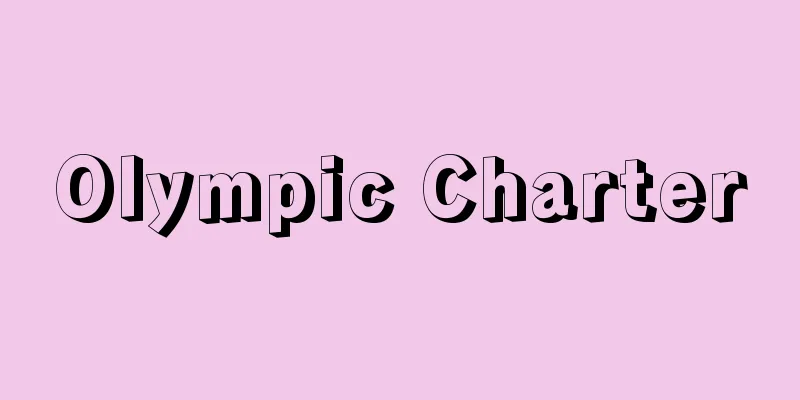
|
This column lists the Fundamental Principles of Olympism and Chapter 1 of the Olympic Charter, which has 61 rules in total and came into effect on June 26, 2019. [Fundamental Principles of Olympism] 2. The purpose of Olympism is to place sport at the service of the harmonious development of humanity with a view to promoting a peaceful society respecting the preservation of human dignity. 3. The Olympic Movement is a coordinated, systematic, universal and permanent movement of individuals and organisations inspired by the values of Olympism, with its highest organ, the IOC. It extends across the five continents and culminates in the gathering of athletes from all over the world in a great sporting event, the Olympic Games. Its symbol is the five interlocking links. 4. The right to participate in sport is a human right. Every individual must be given the opportunity to participate in sport without discrimination of any kind and in the Olympic spirit, which calls for friendship, solidarity and mutual understanding as well as a spirit of fair play. 5. Sports organizations within the Olympic Movement must be politically neutral, recognizing that sport exists within a social framework. Sports organizations have the right and obligation of autonomy, which includes the right to freely define and control the rules of their sport, to determine the structure and governance of their own organisations, to hold elections free from any outside influence, and the responsibility to ensure the application of the principles of good governance. 6. The rights and freedoms set forth in this Olympic Charter must be enjoyed without discrimination of any kind, such as race, colour, sex, sexual orientation, language, religion, political or other opinion, national or social origin, property, birth or other status. 7. Membership in the Olympic Movement requires adherence to the Olympic Charter and recognition by the IOC.
2. The three main components of the Olympic Movement are the International Olympic Committee (IOC), the International Federations (IFs) and the National Olympic Committees (NOCs). 3. In addition to the three main components mentioned above, the Olympic Movement also includes national associations, clubs and individuals affiliated to the Organising Committees of the Olympic Games (OCOGs), IFs and NOCs. The interests of athletes in particular are an important component in the activities of the Olympic Movement. Furthermore, the Olympic Movement includes judges, referees, coaches, other sports officials and technical personnel. Other organisations and institutions recognised by the IOC are also components of the Olympic Movement. 4. Persons and organisations belonging to the Olympic Movement, in whatever capacity they act, are bound by the rules of the Olympic Charter and must comply with the decisions of the IOC. 2. Mission and Role of the IOC * 1. To encourage and support the promotion of ethics and good governance in sport, and the education of young people through sport, and to do all in our power to ensure that a spirit of fair play prevails and that violence is prohibited in sport. 2. To promote and support the organisation, development and coordination of sports and athletics. 3. To ensure the regular holding of the Olympic Games. 4. To cooperate with competent public and private organizations and governmental authorities in the effort to use sport for the benefit of humanity and in that effort to promote peace. 5. To strengthen the unity of the Olympic Movement, safeguard its autonomy, maintain and promote its political neutrality and act to safeguard the autonomy of sport. 6. To act against any form of discrimination affecting the Olympic Movement. 7. Encourage and support the Olympic Movement's elected athletes' representatives to act together with the IOC Athletes' Commission as their highest representative in all matters relating to the Olympic Games. 8. Promote and support the advancement of women in sport at all levels and structures in order to put into practice the principle of gender equality. 9. To lead the fight against doping and protect clean athletes and the integrity of sport by taking action against all forms of competition manipulation and related misconduct. 10. Facilitate and support athlete medical and health care measures. 11. We oppose the inappropriate exploitation of sport and its athletes for political or commercial purposes. 12. To encourage and support the efforts of sports organisations and public authorities in preparing the social and professional future of athletes. 13. Promote and support the development of sport for all. 14. Encourage and support responsible concern for environmental issues and encourage sustainable development in sport, and request that the Olympic Games be held with this in mind. 15. Encourage host countries and cities to continue the positive legacy of the Olympic Games. 16. Promote and support activities that combine sport with culture and education. 17. Promote and support the work of the International Olympic Academy (IOA) and other organizations dedicated to Olympic education. 18. Encourage safe sport and promote the protection of athletes from all forms of harassment and abuse. Bye-Law to Rule 2 2. The IOC Executive Board may grant IOC patronage to other events provided such events are consistent with the objectives of the Olympic Movement. 3. Recognition by the IOC 2. The IOC may recognise as NOCs national sports organisations whose activities are linked to the IOC's mission and role. The IOC may also recognise federations of NOCs organised on a continental or global scale. All NOCs and federations of NOCs shall, where possible, have legal personality. All NOCs and federations of NOCs must comply with the Olympic Charter and their statutes must be approved by the IOC. 3. The IOC may recognise IFs and associations of IFs. 4. Recognition of a federation of IFs or a federation of NOCs shall in no way affect the right of the respective IFs or NOCs to negotiate directly with the IOC and conversely, the right of the IOC to negotiate directly with each IF or NOC. 5. The IOC may recognise non-governmental organisations with links to sport which operate on an international scale and whose statutes and activities are in accordance with the Olympic Charter. 6. In any case, the IOC Executive Board will decide on the consequences of the recognition. 7. Recognition by the IOC may be provisional or full. Provisional recognition and withdrawal, including its duration, are decided by the IOC Executive Board. The IOC Executive Board may also determine the conditions for the expiration of provisional recognition. Full recognition or withdrawal is decided by the IOC Session. All details of the recognition procedure are laid down by the IOC Executive Board. 4. Olympic Congress * Bye-Law to Rule 4 2. The Olympic Congress is composed of the members of the IOC, the Honorary President of the IOC, its Honorary and Honorary Members, representatives of the IFs and NOCs, and may also include representatives of organisations recognised by the IOC. In addition, athletes and individuals invited in their individual capacity or as representatives of their organisations attend the Olympic Congress. 5 Olympic Solidarity * Bye-Law to Rule 5 6 Olympic Games * 2. The Olympic Games consist of the Games of the Olympiad and the Olympic Winter Games. Only sports played on snow or ice are considered winter sports. Bye-Law to Rule 6 2. The Olympiads are numbered consecutively, starting with the first Games of the Olympiad, held in Athens in 1896. The 29th Olympiad began on 1 January 2008. 3. The Olympic Winter Games are numbered in the order in which they are held. 7 Rights in the Olympic Games and Olympic Properties * 2. The Olympic Games are the exclusive property of the IOC, which owns all rights relating to the Olympic Games, in particular but not limited to: (i) the organisation, exploitation and marketing of the Olympic Games, (ii) the authorisation of the taking of still and moving images of the Olympic Games for media use, (iii) the recording of audio-visual recordings of the Olympic Games, and (iv) the broadcasting, transmission, re-transmission, reproduction, display, dissemination and making available to the public any production or signal embodying an audio-visual recording or recording of the Olympic Games or communicating such production to the public in any manner, whether now existing or developed in the future. 3. The IOC will establish the respective terms of access to and use of data relating to the Olympic Games, each match and sports performance. 4. The Olympic symbol and the Olympic flag, motto, anthem, Olympic designations (including but not limited to the words "Olympic Games" and "Games of the Olympiad"), names, emblems, the flame and the torch, as defined in Rules 8 to 14 below, as well as any other musical, audio-visual works or other creative works or artefacts authorised in connection with the Olympic Games by the IOC, a NOC and/or an OCOG, may collectively or individually be referred to for convenience as the "Olympic properties". All rights in and to the Olympic properties and all rights of their use, whether for revenue-generating, commercial or advertising purposes, belong exclusively to the IOC. The IOC may license such rights in whole or in part on conditions to be determined by the IOC Executive Board. 8 Olympic Symbols * 9 Olympic Flag * 10 Olympic Motto * 11 Olympic Emblem * 12 Olympic Anthem * 13 Olympic Flame and Olympic Torch * 2. The Olympic Torch is a transport torch or a replica thereof approved by the IOC for burning the Olympic Flame. 14 Olympic Names * Bylaws to Rule 7-14 1.3 If national laws, trademark registrations or other legal instruments grant an NOC legal protection for the Olympic symbol or other Olympic properties, the NOC may only exercise the rights therefrom in accordance with the Olympic Charter and only in accordance with the instructions of the IOC. 1.4 An NOC may at any time request the IOC for assistance in obtaining legal protection for Olympic properties and may also request the IOC's assistance in settling any disputes arising from such matters with third parties. 1.5 The IOC may at any time request the assistance of the NOC in obtaining legal protection for the Olympic properties and may also request the assistance of the NOC in settling any dispute with third parties concerning such a matter. 2. Use of the Olympic Properties by the IOC and by third parties authorised or licensed by the IOC 2.2 The Olympic symbol, the Olympic emblems and other Olympic properties of the IOC may be used by the IOC and by persons authorised by the IOC in the countries of NOCs, subject to the following conditions: 2.2.1 Any such use must not materially prejudice the interests of the NOC in respect of any sponsorship or supplier agreement and any marketing activities other than those specified in Bye-Law 2.2.2 below. Any such use will be decided by the IOC in consultation with the NOC. The NOC shall receive a share of the net revenues from such use. 2.2.2 NOC shall receive half of the net income, less taxes and expenses, of any such exploitation under any license agreement. NOC shall be notified in advance of any such exploitation. 2.3 The IOC may, at its discretion, authorise broadcasters of the Olympic Games to use the Olympic symbol, the IOC Olympic emblems and other Olympic properties of the IOC and the OCOG for the purposes of promoting the broadcasts of the Games. Such authorisations shall not be subject to the provisions of paragraphs 2.2.1 and 2.2.2 of this Bye-law. 3. Use of the Olympic symbol, Olympic flag, motto and anthem 3.2 NOCs may use the Olympic symbol, and the Olympic flag, motto and anthem for non-commercial activity only, provided that such use contributes to the development of the Olympic Movement and does not diminish its dignity and is subject to the prior approval of the IOC Executive Board. 4. Creation and use of the Olympic emblem by the NOC or OCOG 4.2 The IOC may approve the design of any Olympic emblem provided that it is in its opinion unique and different from other Olympic emblems. 4.3 The area of the Olympic symbol in any Olympic emblem must not exceed one third of the total size of the emblem and the Olympic symbol in any Olympic emblem must appear complete and must not be modified in any way. 4.4 In addition to the above, the Olympic emblem of an NOC must comply with the following conditions: 4.4.2 The identity of the emblem must not be limited to the name or an abbreviation of the name of the NOC's country. 4.4.3 The distinctive elements of the emblem must not be associated with the Olympic Games or with any particular date or event, in order to avoid any temporal limitation. 4.4.4 The elements which identify the emblem must not include a motto, name or other generic expression which may give the impression of being universal or international. 4.5 In addition to the provisions of articles 4.1, 4.2 and 4.3 above, the Olympic emblem of an OCOG must comply with the following conditions: 4.5.1 The design of the emblem must be such that it is clearly associated with the Olympic Games organised by the OCOG. 4.5.2 The identity of the emblem must not be limited to the name or an abbreviation of the name of the country of the OCOG. 4.5.3 The unique elements of the emblem must not include any motto, name or other generic expression which may give the impression of being universal or international. 4.6 All Olympic emblems approved by the IOC before the above provisions came into force shall remain valid. 4.7 The Olympic emblems of NOCs must be accessible to registration, i.e. legal protection, at any time and whenever possible within their country by the NOCs. The NOCs must complete the registration of such emblems and submit a proof of registration to the IOC within six months of the IOC's approval. If an NOC fails to protect its Olympic emblem to its best efforts and to inform the IOC of such protection, the IOC may revoke the recognition of the emblem. Similarly, OCOGs must protect their Olympic emblems in accordance with the IOC's instructions. The protection of the NOCs and OCOGs must not be vis-à-vis the IOC. 4.8 Any use of an Olympic emblem for advertising, commercial or profit-making purposes is subject to the conditions set out in Bye-laws 4.9 and 4.10 below. 4.9 If an NOC or an OCOG wishes to use their respective Olympic emblem for advertising, commercial or profit-making purposes, they must do so in accordance with this Bye-law. Similarly, if they wish to use the emblem indirectly through a third party, they must ensure that such third party complies with these Bye-laws. 4.10 All contracts or arrangements, including those entered into by the OCOG, must be signed or approved by the NOC and are subject to the following principles: 4.10.1 The use of an Olympic emblem by an NOC is valid only within the territory of that NOC. Such Olympic emblem, as well as other symbols, emblems, marks connected with Olympism and the name of an NOC may not be used for advertising, commercial or profit-making purposes in the territory of any other NOC, unless the latter has given its prior written permission. 4.10.2 Similarly, the Olympic emblem of the OCOG and any other symbols, emblems, marks or names connected with Olympism may not be used for advertising, commercial or profit-making purposes in the country of any NOC, unless the NOC has given its prior written permission. 4.10.3 The validity of any contract concluded by an OCOG shall in no case extend beyond 31 December of the year in which the Olympic Games are held. 4.10.4 The use of the Olympic emblem must contribute to the development of the Olympic Movement and must not be derogatory to its integrity. It is prohibited to associate any product or service with an Olympic emblem if this is incompatible with the fundamental principles of Olympism established in the Olympic Charter or with the role of the IOC. 4.10.5 Upon request by the IOC, the NOC or OCOG must provide copies of any contracts to which it is a party. 5. Postage stamps The IOC encourages competent authorities in their countries, in collaboration with the NOCs, to use the Olympic symbol on postage stamps. Such authorities will issue postage stamps in collaboration with the IOC, subject to the conditions established by the IOC. 6. Works commissioned in connection with the Olympic Games The OCOG and the NOC must ensure that procedures are in place to the satisfaction of the IOC, determining that the IOC is the owner of the copyright in any musical works, audiovisual works and other creative works or artefacts commissioned in connection with the Olympic Games. From the 2019 Olympic Charter, English-Japanese translation (effective from June 26, 2019) (The diagram in "8. Olympic Symbol*" is omitted.) [References] | Olympic Charter |
|
本欄は、2019年6月26日から有効のオリンピック憲章の規則(全61項目)のうち、オリンピズムの根本原則と第1章を記載したものである。 【オリンピズムの根本原則】 2. オリンピズムの目的は、人間の尊厳の保持に重きを置く平和な社会の推進を目指すために、人類の調和のとれた発展にスポーツを役立てることである。 3. オリンピック・ムーブメントは、オリンピズムの価値に鼓舞された個人と団体による、協調の取れた組織的、普遍的、恒久的活動である。その活動を推し進めるのは最高機関のIOCである。活動は5大陸にまたがり、偉大なスポーツの祭典、オリンピック競技大会に世界中の選手を集めるとき、頂点に達する。そのシンボルは5つの結び合う輪である。 4. スポーツをすることは人権の1つである。すべての個人はいかなる種類の差別も受けることなく、オリンピック精神に基づき、スポーツをする機会を与えられなければならない。オリンピック精神においては友情、連帯、フェアプレーの精神とともに相互理解が求められる。 5. オリンピック・ムーブメントにおけるスポーツ団体は、スポーツが社会の枠組みの中で営まれることを理解し、政治的に中立でなければならない。スポーツ団体は自律の権利と義務を持つ。自律には競技規則を自由に定め管理すること、自身の組織の構成とガバナンスについて決定すること、外部からのいかなる影響も受けずに選挙を実施する権利、および良好なガバナンスの原則を確実に適用する責任が含まれる。 6. このオリンピック憲章の定める権利および自由は人種、肌の色、性別、性的指向、言語、宗教、政治的またはその他の意見、国あるいは社会的な出身、財産、出自やその他の身分などの理由による、いかなる種類の差別も受けることなく、確実に享受されなければならない。 7. オリンピック・ムーブメントの一員となるには、オリンピック憲章の遵守およびIOCによる承認が必要である。
2. オリンピック・ムーブメントの主要3構成要素は、国際オリンピック委員会(IOC)、国際競技連盟(IF)、国内オリンピック委員会(NOC)である。 3. 上記の主要3構成要素に加え、オリンピック・ムーブメントにはオリンピック競技大会の組織委員会(OCOG)IFおよびNOCに所属する国内の協会、クラブ、個人も含まれる。特に選手の利益はオリンピック・ムーブメントの活動において、重要な構成要素である。さらにオリンピック・ムーブメントにはジャッジ、レフェリー、コーチ、その他の競技役員、技術要員が含まれる。IOCの承認するその他の組織および機関もオリンピック・ムーブメントの構成要素である。 4. オリンピック・ムーブメントに所属する個人および組織は、どのような活動資格であれ、オリンピック憲章の規則に拘束され、IOC の決定に従わなければならない。 2 IOCの使命と役割* 1. スポーツにおける倫理と良好なガバナンスの促進、およびスポーツを通じた青少年教育を奨励し支援する。さらに、スポーツにおいてフェアプレー精神が広く行き渡り、暴力が禁じられるよう、全力を尽くす。 2. スポーツと競技大会の組織運営、発展および連携を促し支援する。 3. オリンピック競技大会を定期的に確実に開催する。 4. スポーツを人類に役立てる努力において、権限を有する公的または私的な組織および行政機関と協力し、その努力により平和を推進する。 5. オリンピック・ムーブメントの結束を強め、その主体性を守り、政治的中立を維持するとともに促進し、スポーツの自律性を保護するために行動する。 6. オリンピック・ムーブメントに影響を及ぼす、いかなる形態の差別にも反対し、行動する。 7. オリンピック・ムーブメントにおいて選出されたアスリートの代表がIOCアスリート委員会とともに、オリンピック競技大会と関連する事項のすべてについて、その委員会の最高権威の代表として活動することを奨励し支援する。 8. 男女平等の原則を実践するため、あらゆるレベルと組織において、スポーツにおける女性の地位向上を促進し支援する。 9. ドーピングに対する戦いを主導し、いかなる形態の試合の不正操作、および関連する不正行為に対抗する行動をとることにより、クリーンな選手とスポーツの高潔性を保護する。 10. 選手への医療と選手の健康に関する対策を促し支援する。 11. スポーツと選手を政治的または商業的に不適切に利用することに反対する。 12. スポーツ団体および公的機関による、選手の社会的、職業的将来を整える努力を促し、支援する。 13. スポーツ・フォア・オールの発展を促進し支援する。 14. 環境問題に対し責任ある関心を持つことを奨励し支援する。またスポーツにおける持続可能な発展を奨励する。そのような観点でオリンピック競技大会が開催されることを要請する。 15. オリンピック競技大会の有益な遺産を、開催国と開催都市が引き継ぐよう奨励する。 16. スポーツと文化および教育を融合させる活動を促し支援する。 17. 国際オリンピック・アカデミー(IOA)の活動およびオリンピック教育に取り組むその他の機関の活動を促し支援する。 18. 安全なスポーツを奨励し、あらゆる形態のハラスメントおよび虐待からアスリートを保護することを促進する。 《規則2付属細則》 2. IOC理事会は、その他のイベントに対しても、オリンピック・ムーブメントの目的と合致していることを条件に、IOCの後援とすることができる。 3 IOCによる承認 2. IOCは、IOCの使命と役割に結びつく活動をする国内スポーツ団体をNOCとして承認することができる。IOCはまた、大陸または世界的規模で組織されるNOCの連合体を承認することができる。すべてのNOCとNOCの連合体は、可能な場合には法人格を所有するものとする。すべてのNOCとNOCの連合体はオリンピック憲章を遵守しなければならず、それらの定款はIOCの承認を得なければならない。 3. IOCは、IFとIFの連合体を承認することができる。 4. IFの連合体またはNOCの連合体を承認することは、それぞれのIFまたはNOCがIOCと直接交渉する権利にいかなる影響も及ぼさず、また、逆にIOCがそれぞれのIFまたはNOCと直接交渉する権利にいかなる影響も及ぼさない。 5. IOCは国際的な規模で運営され、定款と活動がオリンピック憲章に則っているスポーツとつながりを持つ非政府組織を承認することができる。 6. いずれの場合も、承認に伴う帰結についてはIOC理事会が決定を下す。 7. IOCによる承認には、暫定的なものと全面的なものとがある。暫定的な承認と取り消しについては、IOC理事会がその期間を含め決定する。IOC理事会はまた、暫定承認失効の条件について定めることができる。正式承認またはその取り消しについては、IOC総会が決議する。承認手続きのすべての詳細は、IOC理事会が定める。 4 オリンピック・コングレス* 《規則4付属細則》 2. オリンピック・コングレスは、IOC委員およびIOCの名誉会長、名誉委員、栄誉委員IFとNOCの代表により構成される。また、IOCの承認する組織の代表を加えることができる。さらに、個人の資格または組織の代表の立場で招待される選手と個人もオリンピック・コングレスに出席する 5 オリンピック・ソリダリティー* 《規則5付属細則》 6 オリンピック競技大会* 2. オリンピック競技大会は、オリンピアード競技大会とオリンピック冬季競技大会からなる。雪上または氷上で行われる競技のみが冬季競技とみなされる。 《規則6付属細則》 2. オリンピアードは、1896年にアテネで開催された第1回オリンピアード競技大会から順に連続して番号が付けられる。第29次オリンピアードは2008年1月1日に始まった。 3. オリンピック冬季競技大会は、開催順に番号が付けられる。 7 オリンピック競技大会とオリンピック資産に関する権利* 2. オリンピック競技大会はIOCの独占的な資産であり、IOCはオリンピック競技大会に関するすべての権利を所有する。特に(i)オリンピック競技大会の組織運営、活用、マーケティング、(ii)メディアが使用するためのオリンピック競技大会の静止画像と動画の撮影を許可すること、(iii)オリンピック競技大会の音声・映像での収録を登録すること、(iv)放送、送信、再送信、再生、表示、伝播、現存するものであれ将来開発されるものであれ、いかなる方法においてもオリンピック競技大会を音声・映像の登録または収録の具体化による作品や信号を一般の人々に提供すること、あるいは一般の人々に連絡すること。IOCのオリンピック競技大会に関する権利はそれらに限定されない。 3. IOCはオリンピック競技大会、大会の各試合および競技パフォーマンスに関するデータへのアクセスと、データの使用について、それぞれ条件を定めるものとする。 4. オリンピック・シンボルとオリンピックの旗、モットー、讃歌、オリンピックと特定できるもの(「オリンピック競技大会」と「オリンピアード競技大会」を含むがそれらに限らない)、名称、エンブレム、聖火およびトーチは以下の規則8~14が定義する通り、さらに、IOC、NOCおよび/またはOCOGによりオリンピック競技大会に関連して公認されたその他の音楽作品、音声・映像作品またはその他の創作品や人工物は、集合的にあるいは単独で便宜上、「オリンピック資産」と呼ぶことができる。オリンピック資産に関するすべての権利、また、その使用についてのすべての権利は、収益確保の目的であれ、商業的な目的であれ、広告の目的であれ、独占的にIOCに帰属する。IOCはそのような権利の全体または一部について、IOC理事会の定める条件により、ライセンス使用権を与えることができる。 8 オリンピック・シンボル* 9 オリンピック旗* 10 オリンピック・モットー* 11 オリンピック・エンブレム* 12 オリンピック讃歌* 13 オリンピック聖火とオリンピック・トーチ* 2. オリンピック・トーチは、IOCが承認したオリンピック聖火を燃焼させるための運搬用のトーチまたはそのレプリカである。 14 オリンピックの名称* 《規則7-14付属細則》 1.3 国内法、商標登録またはその他の法律文書が、オリンピック・シンボル、またはその他のオリンピック資産の法的保護をNOCに許可する場合でも、NOCがそのことで得られる権利を行使できるのは、オリンピック憲章に従い、IOCの指示に従う場合に限られる。 1.4 NOCは、オリンピック資産の法的保護を得ることについて、いつでもIOCに対し支援を要請することができ、また、そのような問題で第三者と争いが生じた場合には、その解決のため IOCに支援を求めることができる。 1.5 IOCは、オリンピック資産の法的保護を得ることについて、いつでもNOCに対し支援を要請することができ、また、そのような問題で第三者との争いが生じた場合には、その解決のためNOCに支援を求めることができる。 2. IOCによるオリンピック資産の使用、IOCに許可された第三者もしくはライセンス使用権を与えられた第三者によるその使用 2.2 オリンピック・シンボル、オリンピック・エンブレム、その他のIOCのオリンピック資産は、IOCが利用できるほか、以下の条件を満たすことを条件に、IOCが権限を与えた個人がNOCのある国において利用することができる。 2.2.1 そのような利用はスポンサー契約、サプライヤー契約および以下の付属細則2.2.2に明記されるものを除くマーケティング活動に関して、当該NOCの利益を大きく損なうことがあってはならない。利用の決定についてはIOCがNOCと協議のもとに行う。NOCはそのような利用による純益の一部を受け取るものとする。 2.2.2 NOCはすべてのライセンス契約において、そのような利用での税金と経費を差し引いた純益の半分を受け取るものとする。NOCはそのような利用について、事前に通知を受ける。 2.3 IOCは自らの裁量で、オリンピック競技大会の放送会社に対し、大会の放送宣伝目的で、オリンピック・シンボル、IOCのオリンピック・エンブレム、その他のIOCとOCOGのオリンピック資産の使用を許可することができる。このような許可に関しては本付属細則2.2.1と2.2.2の規定は適用されない。 3. オリンピック・シンボル、オリンピックの旗、モットー、讃歌の使用 3.2 NOCは非営利活動に限りオリンピック・シンボル、およびオリンピックの旗、モットー、讃歌を使用することができる。ただし、そのような使用はオリンピック・ムーブメントの発展に寄与すること、その尊厳を損なわないこと、さらにIOC理事会による事前の承認を得ることが条件となる。 4. NOCまたはOCOGによるオリンピック・エンブレムの創作と使用 4.2 IOCはオリンピック・エンブレムのデザインについて 他のオリンピック・エンブレムと異なる固有のものであると判断した場合に承認することができる。 4.3 オリンピック・エンブレムの中に占めるオリンピック・シンボルの面積は、エンブレム全体の3分の1の大きさを超えてはならない。また、オリンピック・エンブレムの中のオリンピック・シンボルは全体を完全に表していなければならず、いかなる修正も加えてはならない。 4.4 上記に加え、NOCのオリンピック・エンブレムは、以下の条件を満たさなければならない 4.4.2 エンブレムが固有のものであることを示す要素は、当該NOCの国の国名、あるいは国名の省略形に限定してはならない。 4.4.3 エンブレムが固有のものであることを示す要素は、時間的な限定につながらないようにするため、オリンピック競技大会、あるいは特定の日付、行事と関連づけてはならない。 4.4.4 エンブレムが固有のものであることを示す要素は、普遍的あるいは国際的であるかのような印象を与えるモットーや名称、その他の総称的表現を含んではならない。 4.5 OCOGのオリンピック・エンブレムは、上記の条項4.1、4.2、4.3の規定に加え、以下の条件を満たさなければならない。 4.5.1 エンブレムは当該OCOGが組織運営するオリンピック競技大会との結びつきが明確に認識できるようなデザインでなければならない。 4.5.2 エンブレムが固有のものであることを示す要素は、当該OCOGの国の国名、あるいは国名の省略形に限定してはならない。 4.5.3 エンブレムが固有のものであることを示す要素は、普遍的あるいは国際的であるかのような印象を与えるモットーや名称、その他の総称的表現を一切含んではならない。 4.6 上記の規定が発効する以前にIOCが承認したオリンピック・エンブレムについては、そのまますべて有効とする。 4.7 NOCのオリンピック・エンブレムはNOCがその国内において、いつでも可能な限り登録できる、つまり法的に保護しやすいものでなければならない。NOCはIOCの承認後6カ月以内に、そのようなエンブレムの登録を完了し、登録証明をIOCに提出しなければならない。NOCが自身のオリンピック・エンブレムについて最善を尽くして保護せず、そのような保護についてIOCに通知しなかった場合には、IOC はエンブレムの承認を取り消すことができる。同様に、OCOGはIOCの指示に従い、自身のオリンピック・エンブレムを保護しなければならない。NOCとOCOGによる保護は、IOCに対抗するものであってはならない。 4.8 宣伝広告、商業的な目的、あるいは営利目的でのオリンピック・エンブレムの使用は、以下の付属細則4.9および4.10の規定で明記する条件を満たさなければならない。 4.9 NOCまたはOCOG が、それぞれのオリンピック・エンブレムを宣伝広告、商業的な目的、あるいは営利目的での使用を望む場合、本付属細則に従わなければならない。同様に、第三者を通じた間接的なエンブレムの使用を望む場合には、NOCまたはOCOGはそのような第三者に、確実に付属細則を遵守させなければならない。 4.10 OCOGが締結したものを含め、すべての契約または取り決めには、当該NOCによる署名もしくは承認が必要であり、かつ以下の原則が適用されるものとする。 4.10.1 NOCのオリンピック・エンブレムの使用は、当該NOCの国内に限り有効である。そのようなオリンピック・エンブレムと、その他のオリンピズムに関係するシンボル、エンブレム、マークおよびNOCの名称は、他のNOCの国内で宣伝広告、商業的な目的、あるいは営利目的で使用することはできない。ただし、後者が事前に書面により許可した場合は、その限りではない。 4.10.2 同様に、OCOGのオリンピック・エンブレムおよびその他のオリンピズムに関係するシンボル、エンブレム、マーク、OCOGの名称はいかなるNOCの国内でも宣伝広告、商業的な目的、あるいは営利目的で使用することはできない。ただし、当該NOCが事前に書面により許可した場合は、その限りではない。 4.10.3 OCOGが結ぶ契約の有効期限は、どのような場合も、当該オリンピック競技大会の開催年の12月31日を越えてはならない。 4.10.4 オリンピック・エンブレムの使用は、オリンピック・ムーブメントの発展に寄与するものでなければならず、その品位を損なうものであってはならない。オリンピック憲章の定めるオリンピズムの根本原則、またはIOCの役割と相容れない場合には、製品あるいはサービスをオリンピック・エンブレムと関連づけるこ とは禁止される。 4.10.5 NOCまたはOCOGは、IOCの要請があれば、自身が当事者となっている契約書のコピーを提出しなければならない。 5. 郵便切手 6. オリンピック競技大会に関連して制作を委託された作品 オリンピック憲章2019年版・英和対訳(2019年6月26日から有効)より(「8. オリンピック・シンボル*」の図は省略)。 [参照項目] |オリンピック憲章
|
Recommend
Lydia Koidula
1843‐86 Estonian poet. Showing talent for poetry a...
Rust (sabi, rust) - Rust (English spelling)
A corrosion product that forms on the surface of a...
Engage ring (English spelling)
...The idea seems to have been inspired by the fa...
Kuril Current
…The common name for the Kuril Current. It was na...
Barbon, N. (English spelling) BarbonN
...Guilds provided mutual assistance to members i...
Pirate films
Among the action films from the Middle Ages to the...
Underemployment - underemployment
This refers to an employment situation in which t...
Phthalic acid - Phthalan
1,2-benzenedicarboxylic acid. C 8 H 6 O 4 (166.13...
Nine Lords
In China, a general term for the heads of various...
Ruzaevka
... Although some industry was established in thi...
Tilapia nilotica (English spelling) Tilapianilotica
… [Makoto Shimizu]. . … *Some of the terminology ...
Minya (English spelling) al‐Minyā
A city in central Egypt and the capital of the pre...
Agrayana - Agrayana
…At the beginning of spring, a ritual is held to ...
Bao Zhao - Hosho
A poet from the Southern Song Dynasty in China. H...
Record office - kirokujo
〘Noun〙① (Abbreviation of "Kirokushoenkenkeijo...



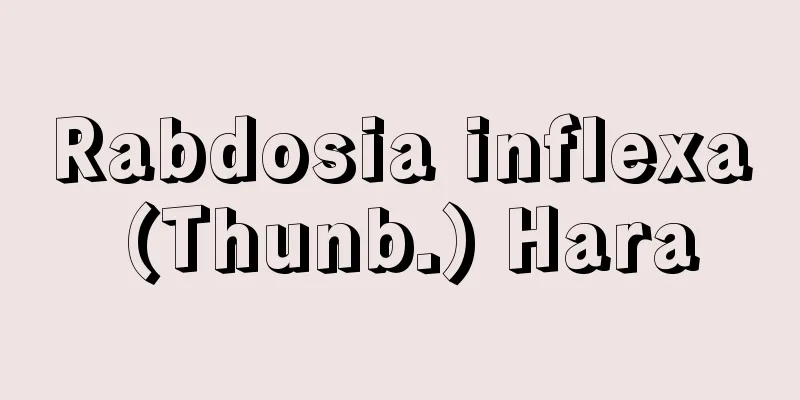
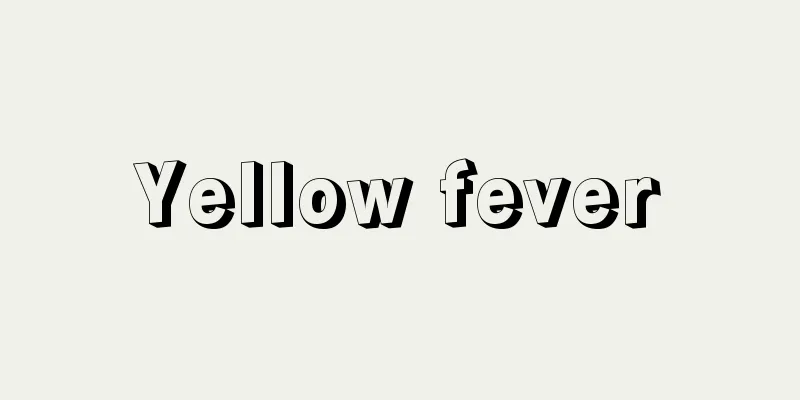
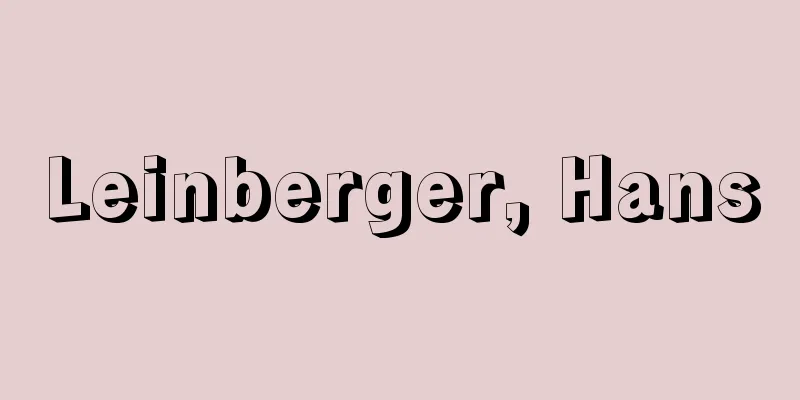
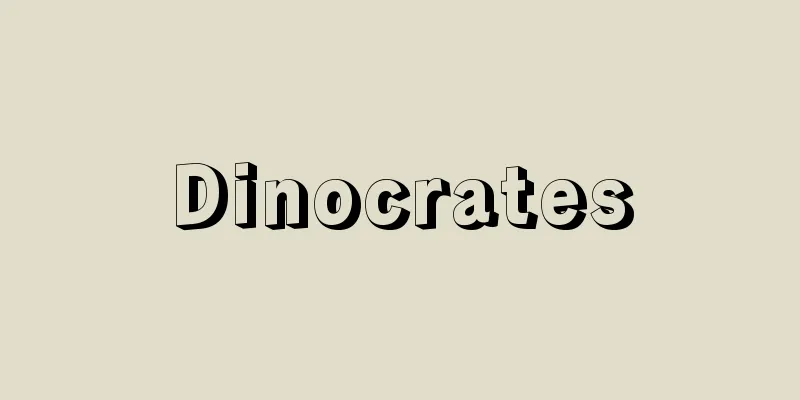
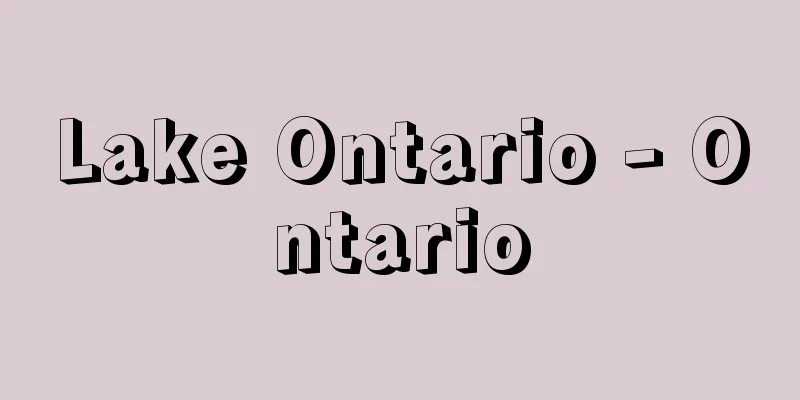
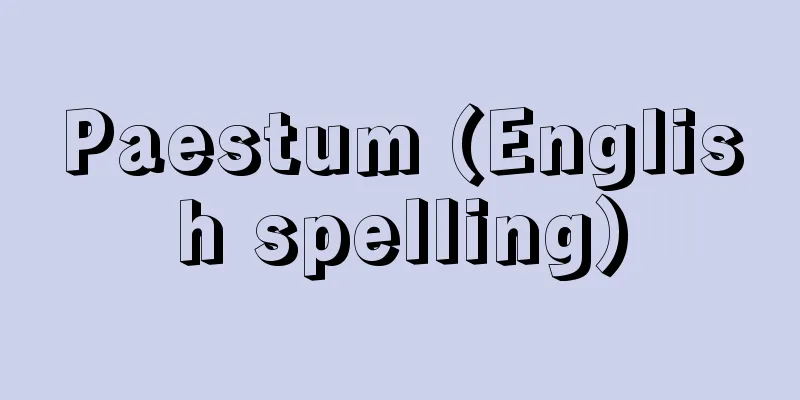
![Asama [Hot Spring] - Asama](/upload/images/67cad31480bd2.webp)